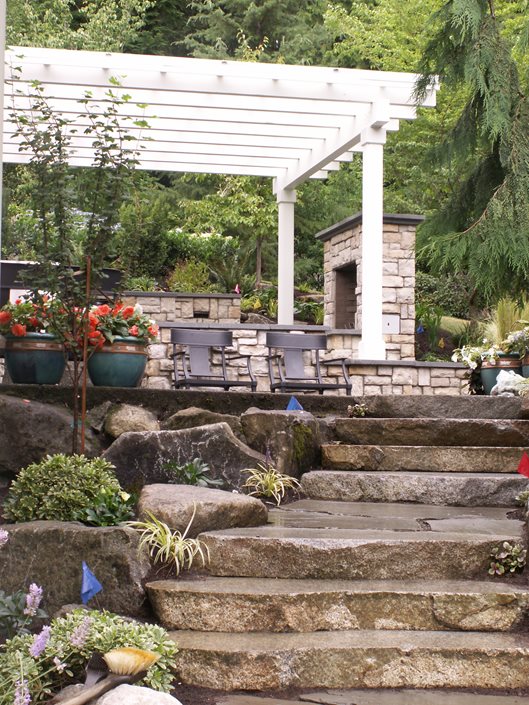Achieve a Stunning Outside Oasis With Thoughtful Steep Hill Landscaping Solutions
Transforming a high hillside into a captivating outdoor sanctuary offers special difficulties that require innovative landscaping services. By attending to problems such as erosion control and accessibility, one can develop a harmonious blend of elegance and performance. Techniques such as terracing, the installment of maintaining walls, and the selection of indigenous plants play vital roles in this procedure. In addition, including water features can further boost the landscape's appeal. However, recognizing the ins and outs of these aspects is important for attaining a genuinely cohesive and inviting setting. What techniques will best match your hill's details attributes?
Recognizing Steep Hillside Difficulties
Landscape design on steep hills presents unique challenges that require mindful factor to consider and critical preparation. The inclination of the terrain can lead to issues such as dirt disintegration, water overflow, and limited ease of access, all of which have to be resolved to produce a practical and aesthetically pleasing exterior area.
One of the primary worry about high hill landscaping is disintegration, which can result from heavy rains or incorrect drainage. This not just impacts plant health but can additionally endanger the stability of the incline. Executing reliable erosion control actions, such as growing deep-rooted plant life or using mulch, is crucial in protecting the integrity of the landscape.

Creating With Terracing Methods
To minimize the obstacles postured by high hillsides, including terracing strategies can be an effective solution. This design approach transforms a sloped landscape into a collection of level, degree locations, producing an aesthetically striking and practical outside area. Terracing not only helps to prevent soil disintegration yet additionally assists in much better water drainage, which is important in preserving the health of plants and the stability of the hill.
The use of indigenous plants on each level can boost biodiversity, promote sustainability, and reduce upkeep needs. In addition, integrating pathways in between terraces can boost availability and encourage expedition of the landscape.
Terraced gardens can offer several purposes, including veggie production, decorative displays, or outdoor seats areas. By using materials that mix harmoniously with the surrounding setting, the terracing can improve the total aesthetic allure of the building. Eventually, thoughtful terracing changes steep hills right into functional, attractive spaces that welcome communication and pleasure.
Applying Keeping Wall Surfaces
When encountered with the challenges of high surface, implementing maintaining wall surfaces can offer both architectural assistance and aesthetic enhancement to a landscape. These walls offer to prevent dirt disintegration, maintain inclines, and create flat locations for horticulture or recreational use. Steep hill landscaping. By successfully taking care of water runoff and decreasing dirt check my site motion, preserving walls safeguard your landscape investment while enhancing safety and security

Expert installment is vital to ensure the long life and efficiency of preserving walls. Correct drain systems have to be integrated to relieve hydrostatic pressure, preventing architectural failing. Consulting with landscape experts will certainly ensure that the style aligns with your general vision page while sticking to local guidelines.
Choosing Native Plants
Picking native plants for your landscape style supplies various environmental and visual benefits. Steep hill landscaping. Native plants are adjusted to the local climate and soil problems, requiring less water and maintenance contrasted to non-native varieties. This adaptability not only saves sources but likewise advertises a much healthier ecosystem, as native plants support regional wild animals, consisting of pollinators such as bees and butterflies
Incorporating native plants right into your steep hill landscaping can improve dirt security, reducing erosion and promoting a balanced ecological community. Ingrained native plants help anchor the soil, making them suitable for sloped locations. These plants often exhibit vibrant shades and varied appearances, developing an aesthetically enticing landscape that integrates with the surrounding setting.
When picking indigenous plants, consider their development habits, seasonal interest, and compatibility with various other varieties. Organizing plants with comparable water and sunlight demands can cause an extra cohesive style, while likewise simplifying maintenance. By selecting native plants, you not just cultivate a sustainable outdoor oasis but also add positively to the regional biodiversity, guaranteeing that your landscape prospers for several years ahead.
Incorporating Water Functions
Including water attributes right into your steep hillside landscape design can substantially improve both the aesthetic allure and environmental functionality of the room. The sound of flowing water creates a calm environment, while aesthetically, it can function as a centerpiece that draws the eye and includes depth to the landscape.
When choosing water attributes, take into consideration alternatives that match the all-natural contours of your hill. Waterfalls, for circumstances, can cascade the incline, producing visual interest and promoting healthy and balanced drain. Fish ponds can likewise be incorporated into the design, encouraging regional wildlife and giving habitats for numerous species.
Additionally, the placement of plants around these features is critical. Native marine plants not only improve the appeal of the water attribute but also contribute to its ecological equilibrium by filtering pollutants and offering food for neighborhood animals.
Upkeep is one more key aspect; make sure that your water attribute is developed for very easy maintenance. An appropriately built feature will require minimal straight from the source treatment, allowing you to take pleasure in the beauty and peace it uses without extreme labor. Ultimately, thoughtfully bundled water features can change your steep hill landscape right into a fascinating exterior sanctuary.
Verdict
Finally, changing a steep hill right into a gorgeous outdoor oasis requires thoughtful landscaping strategies that deal with erosion control and availability. The integration of terracing techniques, the application of retaining wall surfaces, and the selection of indigenous plants are necessary elements of effective design. In addition, integrating water features boosts both aesthetic allure and water drainage performance. With mindful planning and execution, steep hills can come to be calm retreats that offer both performance and visual delight.